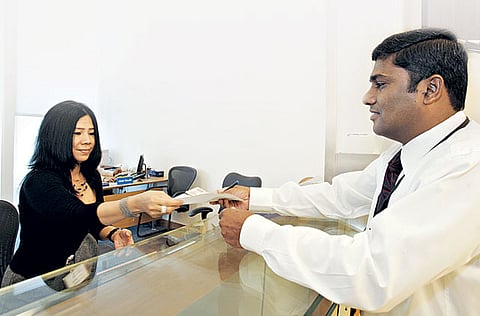Interest rate cuts to impact UAE banks’ profitability
Gross yields on loans will decline more than the funding costs

Dubai: The two consecutive rounds of interest rates cuts in March are expected to adversely impact profitability of UAE banks, according to rating agency Moody’s.
The Central Bank of UAE (CBUAE) along with other Gulf Central Banks lowered key lending rates on March 16, following a 100 basis point (1 per cent) rate cut by the Federal Reserve to counter the economic effects of the coronavirus.
GCC central banks track the Fed rate as most Gulf currencies, with the exception of Kuwaiti dinar are pegged to the dollar.
Rating agency Moody’s said, sharp cut in interest rates will adversely impact profitability of UAE lenders this year.
Decline in NIMs
“The sizable cut in interest rate will reduce UAE banks’ net interest margins (NIMs) because gross yields earned on loans will decline more than the funding cost paid on deposits, and because the rate cut is unlikely to materially increase credit volumes in the current difficult operating environment,” said Mik Kabeya, an analyst at Moody’s.
With the latest round of rate cut of 75-basis-points, the interest rate on certificates of deposit is down by a large 125 basis points since 4 March. According to Moody’s, UAE banks’ net interest income, which depends on the NIM as well as on lending and borrowing volumes, comprised around 70 per cent of their total revenue in 2018.
“Weaker profitability from lower interest rates and NIMs will compound existing pressure on profitability from our expectation of low credit demand and higher provisioning requirements for UAE banks this year, amid challenging operating conditions,” said Kabeya.
Moody’s expect the coronavirus pandemic to generate a broad-based shock to the economy, hurting tourism, transportation, trade and real estate. Also, the economy was already affected by slower population growth, regional geopolitical tensions, low oil prices and the dirham’s strength against the currencies of key origin markets for tourism.
Weaker profitability from lower interest rates and NIMs will compound existing pressure on profitability from our expectation of low credit demand and higher provisioning requirements for UAE banks this year, amid challenging operating conditions.Mik Kabeya, an analyst at Moody’s.
Analysts said the UAE banks’ asset quality to materially deteriorate, although the CBUAE’s Dh 100 billion ($27.2 billion) Targeted Economic Support Scheme and other measures will mitigate the extent of the deterioration by keeping some borrowers’ liquidity issues from becoming solvency issues.
Loan re-pricing
Moody’s said lower interest rates will decrease UAE banks’ gross yields as they gradually reprice their loans, around 81 per cent of which were corporate, government and public sector loans at yearend 2019, which typically have floating rates that reset at intervals of around three to six months.
Lower gross yield will also reflect the UAE’s competitive market and subdued economic and private credit growth, combined with lenders’ focus on high-quality large corporate and government-related borrowers rather than the small and midsize corporate segments that are prone to higher delinquencies.
According to Moody’s estimates UAE banks’ overall credit growth was 6.2 per cent in 2019, driven primarily by 23.2 per cent growth in credit to the government and the public-sector (14.9 per cent excluding a large government-related short-term facility). Private-sector credit, which accounts for 65 per cent of total credit in UAE, grew only 0.4 per cent amid limited wage growth and headcount rationalisation.
Rise in funding costs
Although lower interest rates will reduce banks’ funding costs, the rating agency said they expect the reduction to be less than the decline in gross yields because current and savings deposit accounts comprised 51 per cent of UAE banks’ deposit base (excluding government deposits, commercial prepayments and borrowings under repurchase agreement) at year-end 2019 and these accounts already have a zero or negligible interest rate that has limited room to move lower.
The cost on term deposits will decline gradually and with a lag given the market power of large government-related and private depositors that control a sizeable portion of the UAE’s concentrated deposit pool.
“We expect varying declines in banks’ NIMs, which averaged 2.4 per cent systemwide during 2019. Banks with the highest proportion of corporate loans and highest proportion of current and savings deposits will be the most negatively affected,” said Kabeya.
Sign up for the Daily Briefing
Get the latest news and updates straight to your inbox



